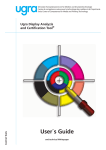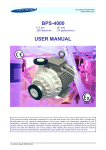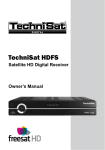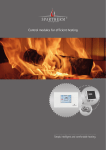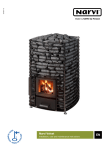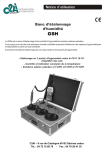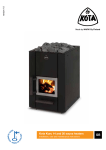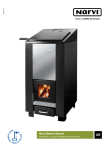Download Schwank IC-90 Series Installation manual
Transcript
ThermoControl Plus M1 2-stage or modulating controller with one control zone (alternative: two control zone 1-stage) Operating and Installation Manual Schwank Ltd. – 62 Sunningdale Road – Sutton, Surrey SM1 2JS Tel: +44 (0)208- 641 3900 Fax: +44 (0)208- 641 2594 E-mail: [email protected] Internet: www.schwank.co.uk Subject to technical changes. Version 01/12 Content: 1 INTRODUCTION ................................................................................................. 3 2 YOUR SAFETY ................................................................................................... 4 3 STRUCTURE AND FUNCTION .......................................................................... 5 4 OPERATION ....................................................................................................... 6 4.1 Basic knowledge of operation ...................................................................... 6 4.1.1 Further readable information ..................................................................... 6 4.1.2 Selection of the control zone ..................................................................... 7 4.1.3 Activation and deactivation of the shown control-zone.............................. 7 4.1.4 Special information in the base display ..................................................... 7 4.2 Display and change of day- and night temperature ...................................... 8 4.3. How to read and modify time and date........................................................ 9 4.4 Timing ........................................................................................................ 11 4.4.1 How to read a time program .................................................................... 11 4.4.2 How to clear a switching point ................................................................. 12 4.4.3 How to clear a whole time program ......................................................... 12 4.4.4 How to protect the time program ............................................................. 12 4.4.5 How to program the switching points....................................................... 13 4.5 Holiday program ......................................................................................... 14 4.6 Manual operation FIX .............................................................................. 15 4.7 Button for chimney-sweep mode ................................................................ 15 5 SET UP THE OPERATING PARAMETERS ..................................................... 16 5.1 Enter the number of control zones ............................................................. 16 5.2 Set up the parameters in the display .......................................................... 17 5.3 The warm up time optimiser ....................................................................... 18 5.4 COPY ......................................................................................................... 19 5.5 How to do a security save and how to reload all parameters: .................... 19 6 INSTALLATION ................................................................................................. 20 6.1 General security instructions ...................................................................... 20 6.2 Sensor connections .................................................................................... 20 6.3 Connection of the heaters .......................................................................... 20 6.4 Maximum load ............................................................................................ 21 6.5 Wiring connections ..................................................................................... 21 6.6 Flue fan connection .................................................................................... 21 6.7 Alarm contact input .................................................................................... 21 6.8 Remote-Control .................................................................................... 22 6.9 Signal input fault ......................................................................................... 22 6.10 Humidity contact inputs ............................................................................ 22 6.11 Common fault signal ................................................................................ 23 7 TECHNICAL PARAMETERS ............................................................................ 24 8 APPENDIX ........................................................................................................ 25 -2- 1 Introduction The Schwank ThermoControl Plus M1 is suitable for 1-stage, 2-stage or modulating gasinfrared heating systems as well as for gas-fired warm air heaters. Dependant upon its operation the controller has one or two control zones. Please read this manual carefully before installing or using the control-unit. Failure to follow the notes and warnings will affect your guarantees. They are also a prerequisite for a professional installation and correct handling. Please pay special attention to chapter 2 „Your Safety“. The ThermoControl Plus M1 is designed to be used for industrial/commercial building heating systems only. Other or further uses are not permitted. Schwank GmbH will not be held responsible for any damages whatsoever resulting from incorrect use. - The controller measures the room temperature and switches the heater on/off by relays. - The controller features three operating programs. P0: single-stage control mode for gas fired air heater P1: single -stage controller for gas-infrared heaters P2: two -stage or modulating control for gas-infrared heaters Override day temperature mode +h Available as a special feature is the extension of the programmed heating period by a manually operated button. This button can be installed parallel to the sensor. By pushing the button (~1 sec.), the nominal value of the programmed temperature in the selected control circuit is maintained for an additional programmable time period. (Standard 1h) Programmed temperature values and operating programs The temperatures and operating programs of every single control circuit are independently selectable. - Day, nightor anti-freezing temperature , selected by a week program - Continuous day-( FIX) night-( FIX) or anti freezing temperature ( FIX). - Holiday program: the controller is able to save eight holiday periods, which are programmed according to the calendar. Other Tools/Features: – Illuminated display – Button for chimney-sweep operation mode – Real-time clock with calendar, including automatic summer- / wintertime correction – Outdoor temperature sensor (ATF) – Optimised warm-up: the heater starts/switches on earlier to ensure that the desired temperature is achieved at the programmed time. – Remote controlled day-mode operation – Working-hour/time-counter at every relay output – Error-relay: relay switches on in any case of error – Potential-free contact inputs to connect humidity sensors -3- 2 Your Safety Installation details Danger! Note that electric shocks can be highly dangerous. Pay attention while working on electrical equipment. The electrical installation must be carried out by a qualified engineer to the current national and international standards. Check the electrical equipment regularly. Defective wires etc. must be replaced immediately. The appliance must be isolated from power supply before working with the electrics. Make sure that nobody can connect appliance to the power supply while you are working. The Schwank ThermoControl Plus 1 has to be mounted on/at a place, where it’s not affected by vibrations or shocks. The feed/supply line has to be protected by a fuse with max. 16 A on the part of the builder. Please install the ThermoControl Plus 1 ensuring conformity to the wiring diagram, which is located in the switchboard. Ensure that the controller and consumer are connected by a 1.5 mm2 cable, further on controller and sensor have to be connected by a telephone cable. -4- Install the room-temperaturesensor between the radiation area of two heaters at a height of 2.5 m. Therefore the controller receives an optimal value of the nominal temperature. + If the controller is installed in a large sized building or in a building with extreme temperature differences (temperature gradiants), you can also average over, instead of using room-temperature-sensors for every single control circuit. Settins and modification of the function parameters can be carried out only by Schwank service technicians. 3 Structure and Function Front panel layout: 1. I/O Main switch on / off 2. LCD Display: All functional- and operating-information is shown in the base display mode (upper picture).The control-unit switches back to the base display, if no button is pushed for more than one minute. If you push the button or the button the day or night set value will be 3. shown/displayed immediately. By using the +/- buttons the values can be modified. 4. + / - With these buttons the display values can be increased or decreased. 5. DISP "“Display-button“: To change the display. This button also offers the ability to switch back to the main menu immediately. 6. SEL „SELECT”: This button allows you to select a certain parameter out of every parameter shown in the display. The chosen/selected parameter can be modified by the +/- buttons. 7. Clock-button: Can be used to display and modify time and date. FIX To change between programmed and FIX modes and back. 8. 9. PR To check and modify the weekly time program in the displayed control circuit. 10. CLR „Clear-button“: To delete a switch-point or a complete time program. 11. Copy This button can be used to copy time- and temperature programs. 12. ERROR The system-error lamp flashes for any kind of error. An arrow will provide information about the cause. 13. ZONE To switch between different control circuits. 14. To turn on/off the single control circuits. 15. SERVICE „Maintenance”: If this sign appears the system needs maintenance, please call the official Schwank service. 16. Button to program holiday operation mode. 17. Button for chimney-sweep operation mode: all control circuits heat full load. -5- 4 Operation 4.1 Basic knowledge of operation By starting the ThermoControl Plus M with the I/O -button an automatic display-test is activated. The controller starts up with the factory-made standard-program. Afterwards the display switches to the base-program, which shows all the important operational information. This number informs: which relay output and which sensor inputs are used in the specific control circuit. Measured temperature Recording device of the chosen control circuit in the room/zone (18.2°C) Actual control mode, in day this case: The extract fan is mode working (optional) 4.1.1 Further readable information Present status of the heater: Full load or Modulating Partial load Heater is turned off The main/base display gives all important operating data, further information can be received by pushing the DISP button. Display of the actual heating power in % Value of the entered anti-freezing temperature . The displayed value can be changed by the +/- buttons. Range of setting: +3… +20°C Display of the outside temperature (only in case of an outdoor temperature sensor ATF). Working-time counter: At 2-stage/modulating control the circuit time of both stages (1,2) will be shown. Push the SEL button to switch between the stages. The shown data cannot be deleted, after 199999 hours the display switches back to zero. -6- 4.1.2 Selection of the control zone The display of the controller and its usage is based on the display of the control circuit. The control zone can be chosen by pushing the ZONE button. Now, all settings of the control zones can be managed and progressed. 4.1.3 Activation and deactivation of the shown control-zone If you want to stop heating a certain zone push the button. The symbol will sign the deactivation of the zone. In the deactivated zone only temperature measurement and display are still working. You can activate the control zone again by pushing the button. 4.1.4 Special information in the base display sign will be While using the holiday-mode the marked. To stop or modify the holiday program, please push the button (chap. 4.5). During the optimised warm up time you will notice the OPT symbol. The activation time of a specific zone is accelerated in dependency of the preheating performance compared to the entered heating time. This function can be deactivated only in the setup-menu. An outside sensor ATF is necessary. Option: By pushing the override button the day mode starts for a pre-programmed time (0:00-24:00h; standard 1h). At the same time the +h symbol will be marked. The mode can be stopped by using the FIX button. -7- 4.2 Display and change of day- and night temperature The desired temperature for every control circuit can be programmed separately. The current day- or nighttemperatures can be or displayed, if you push button. The displayed values can be modified by pushing +/-. All modifications are saved immediately. The temperatures can be changed on a scale of: +3 up to +35°C Pushing the DISP button, (automatically after one minute, without pushing a button) the current display switches back to the main display. -8- 4.3. How to read and modify time and date To read and modify time and date, the button has to be pushed. All control circuits include a separate time-program. This function takes place at the collective button clock. At first the time is shown (in the picture: 14:03). Afterwards you have to use the again, to be able to change the year (2007), after pushing the button for the third time month and day (in this case: 3 = March 21) are announced. „3 Day” stands for the third day in the ongoing week, in other words: Wednesday. ( 1= Monday, etc.) After using the button once more the display switches back to the normal clock. The display ends at the base display, if you press the DISP button. Setting the time Remark: symbols or figures, which are framed are blinking ones! To change the time, the SEL button has to be pressed. At first the minutes start to blink (03), which can be modified by using +/-. After pushing the SEL button again, the hours will start to blink. (14) The hours can also be changed with the +/buttons. The setting of the time can be finished by using the button. Afterwards the display goes back to the year. -9- Setting the year After the time has been modified, you have to set the right year, month and day as well. Otherwise the automatic summer- / wintertime correction won’t work correctly. To change the year, you have to press the SEL button. The last two figures will start to blink (06), they can be modified with the +/- buttons. Afterwards the button has to be pushed and month and day respectively will be shown on the display. When the year has been modified, the day of the week might be changing, according to the calendar (in this case 3). Setting the month and day To change the setting you have to press SEL. At first the month (5) will start to blink, the setting can be modified with +/-. To change the day please push the SEL button again. Now, the day starts to blink (21). The day can also be modified with the buttons +/-. Once more the day of the week changes according to the calendar (first from 3 to 6, then from to 7). If the setting is completed push DISP. After pushing the button, the display switches back to the base display. - 10 - 4.4 Timing Every control circuit has an independent time program, which is able to be modified. The time program is a series of different circuit times. The controller changes automatically from day, to night- or antifreeze modeA circuit/switching point of time can be described as: - time (hour and minute) - temperature mode , or , which will start at this point of time - day of the week, or couple of days, when the switching time should work (1 = Monday, 2 = Tuesday ……7=Sunday) - number of switching points of time (max. 19 times in one program) 4.4.1 How to read a time program To read off the program, please press PR. After you have pushed the PR button, the number of free and available switching points shows up. (here: still 17 switching points available). In the next step the display changes to the first switching point. In this case the display shows: At 6.00 o’clock in the morning on every day of the week (1 2 3 4 5 6 7 Day) the controller is instructed to change to day temperature The small number on the display (1) is the program number of the switching point. To read off the second switching point of time (2) you have to press the PR button. In the picture: 9.00 o’clock in the evening on every day in the week (1 2 3 4 5 6 7 Day) the controller switches to night temperature . If you repeat the process again and again by pushing the PR button the picture with a free switching point shows up (for example 3). The horizontal lines stand for a free switching point, that can be modified. After a free switching point all following ones are available as well. (here: 4 … 19). To quit the menu you have to push the DISP button. To get back to the first switching point push the PR button. - 11 - 4.4.2 How to clear a switching point If you want to clear a switching point, you have to push and hold the CLR button. The symbol CLR will blink in the display, so that you are warned you are going to clear a switching point. If the CLR button is released immediately the cancellation will be stopped. If the cancellation is completed horizontal lines are visible. Afterwards the new number of free switching points is displayed. The numeric of a switching point is not fixed. If a switching point is deleted the numbers of the remaining points will be assigned again, thus there is no chance of holes in the time program. 4.4.3 How to clear a whole time program To clear a whole time program you have to push and hold the CLR button while the number of free spaces are shown in the display (FrEE). The symbol CLR will start to blink, to warn you. If the button is released immediately the cancellation of the program will be stopped. The cancellation is completed, if horizontal lines become visible. That is followed by the new number of free spaces (19). 4.4.4 How to protect the time program The function of the time program is based on the clock and calendar data. The clock is supplied by a battery (1,5 V AA). A warning signal shows, when the battery has to be changed. The exact time and date won’t get lost while the battery is getting changed (for 2 minutes). In case of not using the control-unit for a long time, including a complete discharge of the batteries, you will have to check, if time and date are still correct after a battery change, to avoid problems. The saved switching points are independent of the battery charge, because the program is saved on a secured EEPRON-memory card. Thus time programs cannot get lost as a consequence of a battery change or in the case of any other mistake. - 12 - 4.4.5 How to program the switching points In this example we program the following circumstance: The day temperature should start every morning at 7:35 from Monday till Friday. First of all we are searching for a free switching point by using the PR button. Then we press the SEL button to modify the new data. The same procedure can be used for existing switching points. At first the type of temperature starts to blink. Now you are able to chose and button between by using the +/- buttons. Now you can select the day program with the SEL button. Then the whole week appears: 1234567 Pressing +/- you are able to select different day groups or only single days (1=Monday). Afterwards you can modify the hour by pushing the SEL button (12). The requested time (7) can be achieved with +/-. After that you select the minutes with SEL (00). The requested time (35) can be adjusted with +/-. Finally the PR button has to be pushed. The SET – symbol starts to blink shortly, while the data is being saved. Afterwards the display switches to the next free switching point. It is not possible to program two different switching points with the same time parameter. In case of a saving mistake of two switching points for the same time, the time of the last programmed point will be corrected by one minute. In this case a new switching point was programmed with a time parameter of 7:35. Unfortunately this time parameter was used already in switching point 3. Thus the time - 13 changes automatically to 7:36. 4.5 Holiday program The controller gives you the opportunity to program 8 holiday phases. Beginning and ending of the holidays is displayed with exact data (year, month, day). The programs can be changed and also stopped at every point of time. During the holiday program the anti-freezing temperature will be maintained. To program the holiday periods push the button. At first the number of the holiday program HOL 1 (holiday 1) appears. The numeric above the holiday number shows which program is activated. A programmed holiday period starts automatically at the programmed date. Within the SEL button you are able to start or stop the programmed holiday period. If the program is switched off(program number does not appear) it won’t start, a running program would be shut down respectively. By using +/- you are able to choose one of the 8 holiday programs. The holiday program starts in all control circuits, which are working in the automatic mode a control circuit is working on a fixed mode FIX, the holiday program has no effect on this function. . If If you push the button again, the start of the holiday period can be modified(A): by pressing +/- you can set up year, month and day. The holiday program starts off at 0.00 o’clock on the desired date. After you have modified the start (A), you will have to set up the end (B) of the holiday period. To fix the date please use the +/- button. The completed program ends at 0.00 o’clock on programmed day. It is possible, that the ERR symbol appears, while you are programming the holidays: - if start date A is later than the programmed end of the holiday period B - if the end of the period B is earlier than the present date. A program, that indicates one of these problems, wouldn’t start. If all errors are eliminated the ERR –symbol disappears. Press button to finish programming, the display switches back to HOL.1. Now you can select the next holiday program and start its modification, otherwise you can get back to the main display by pushing the DISP button. - 14 - 4.6 Manual operation If you use the FIX FIX button, you are able to select different operating modes. To change the FIX mode you have to push the FIX button. Press DISP, if the desired operation mode appears (for example: continuous FIX mode). The controlunit switches back to the main display and the selected mode is activated. day-temperature mode night-temperature mode anti-freezing temperature Push FIX to get back to the main display. 4.7 Button for chimney-sweep mode By pushing the button the heaters in every Zone start to run with full power independent of the current room temperature. You can switch back to normal operating mode by pushing this button again. You can clear the chimney-sweep mode separately in zones: select the zone where you want to clear chimneysweep mode by pushing the Zone button, then push Clr button. Full power operation (100%) is cleared and display goes back to normal mode in this zone. The arrow starts to flash indicating that in other zones the chimneysweep mode is still active. - 15 - 5 Set up the operating parameters The set up is made with the buttons on the front. To modify the parameters you have to have technical knowledge, otherwise a faultless function might not be maintained. To avoid unwanted modifications a special procedure must be carried out to open parameter settings. Without this procedure the parameters can be displayed but modification is not possible. Before you open the control unit, please read the security advice in chapter 2! The selection of the control mode (Two-stage/Modulation) or the application program P0, P1 and P2 must only be carried out in a zero-potential state. The application program can be selected at the controller unit (P0, P1, P2). A small “jumper“ has to be placed in the correct position. Only one program can be chosen at any one time. Please be careful by choosing the right electrical connection for the desired application program! In case of changing the application program(P0, P1, P2) all parameters switch back to the factory setting (chapter 5.1 und 5.2) ! P0: 2 Control zones gas fired air heater P1: 2 Control zones, single-stage P2: 1 Control zone, two-stage or modulation Control mode can be selected by a small separate jumper: Upper position: modulating control mode Lower position: two-stage control mode Modulating control mode selection is possible only if the relay outputs are connected to modulating heaters through the special Modulation Box. Modulating control mode selection when 1- or 2-stage heaters are connected to the unit will cause bad operation. 5.1 Enter the number of control zones The controller is able to manage one or two control zones, depending on the chosen application. In the following example we try to fix the actual number of control zones. Hold the ZONE button for about 3 sec. The number of available control circuits appears in the display (for example.: 1-2: two control zones). The desired number of control zones can be selected if you push +/- (1-1). Protected function ! Get back to the normal functions by pushing the DISP button. - 16 - 5.2 Set up the parameters in the display Parameter set up is a protected function. A special process must be carried out to enable modification. In basic mode parameters can be displayed by DISP and SEL buttons but modification is not allowed. To set up the parameters please hold the DISP button for circa 3 seconds. The „Par” symbol appears for a short time. The parameters can be selected with the SEL button. Integration band: Modulating: 1,5 … 9,9°C 2-stage: 0,5 … 3,0°C single-stage: --.-Integration time: 10 … 99 minutes (only in two-stage/modulation mode), in single-stage mode, or in off-state (--.--) appears. Hysteresis , can be activated by 0.2 … 2.0°C Sensor correction: if the sensor could not be mounted at an optimal place, the measured temperature can be revised: -9.9 … +9.9°C Ability of a restart: t1: After starting the heater, it runs with full power until it stops at the programmed time, in this case: 0…15 minutes. t2: For the displayed time, the heater stops completely (5…60 Sec). It only appears, if the t1 doesn’t equal zero. t3: The heater starts off with full load for 1 minute, afterwards the controller switches to the regular mode (0: off). It does not appear unless the twostage control is selected. Min. turn on time of the heater (0...30 min) - 17 - Programmable time for the override button +h (0:00-24:00) Switch off the extract fans: ’AUt’: extract fan in use, ’OFF’’: the extract fan is switched off (also the symbol doesn’t appear). Extract fan follow-up-time : After the heating circuits have been switched off, the extract fan continues until the programmed time is achieved. From 0 up to 60 minutes can be programmed (it appears only in the ”AUt” ventilation mode). The optimised warm up time can be switched on (AUt) or off (OFF). The effective warm up time is shown. Start value of heating power display 0…90% (only at 2-stage or modulating control mode). The illumination of the display can be programmed: 1…9 minutes, switched on (ON) or switched off (OFF). Automatic switch from summer- over to wintertime (+/- 1h). This function can be activated (AUt) and deactivated (OFF). Feature selection of the contact input no. 72-73: : remote contact RES-ERR: signal input - Error If the controller is integrated into a communication module, other parameters will follow. 5.3 The warm up time optimiser The optimised warm up time only works out well, if the sensor ATF is connected to the controller. The program works automatically and doesn’t need to be adjusted. The optimised warm up time follows an easy principal: the controller switches on the heater earlier than it is programmed, so the desired temperature is achieved at the favoured time. Temperature differences and the current outside temperature are integrated in the calculation for the warm up time. The control-unit incorporates the heating characteristics of the building and adjusts the starting point of the warm up time to the effective situation. Every control circuit has an separate optimised warm up time. - 18 - 5.4 COPY The COPY button offers you the opportunity to copy all parameters of a certain circuit or the complete time program and insert it into the program of one or many other control circuits. To copy parameters hold DISP (approx. 3 sec., chapter 3.11). Protected function! To copy time programs use the PR button (chapter. 2.2). To exemplify the procedure, we try to copy data of ZONE1. ZONE, signal and number of Zone 2 start to blink. „COPY“ appears in the display to signalise the copy mode. Push COPY to paste the data of Zone 2 (heating area 2). The data of ZONE 1 are now copied into ZONE 2, The numeric 2 is signalling the completion of the copy process. To finish the copying of the parameters you have to press DISP, while you have to use the PR-button to finish the copying of time programs. 5.5 How to do a security save and how to reload all parameters: The Schwank service technician can save all operational parameters as a package on a save memory card. In case of changing the parameters unintentionally and a resulting functional damage causes problems in the system, the system can be modified to the old parameters easily, according to the purpose built memory card. It is also possible to reload the factory settings. Protected function! If you press CLR and SEL simultaneously, the „LOAd” Press CLR and + symbol appears in the display. Then press the DISP button simultaneously. The „SAVE” and the parameters, that were saved by the Schwanksymbol will appear in the service technician, will start to reload. Switch from „LOAd” to display. Now push DISP, the „FACt“, by using the +/- button. If „FACt” appears in the display will start to blink, the display push the DISP button and the factory parameters parameters are saved, are reconstructed. afterwards the display switches back to the main menu. - 19 - 6 Installation Bracket Lower part 140 25 96 265 244 Door Lock Upper part Screw 180 205 6.1 General security instructions The appliance must be isolated from the power supply while installation - or connection works are carried out! The disconnection of the main control switch I/O doesn’t indicate a complete zero potential of the controller! We recommend that all installation works have to be carried out in accordance with the national “Rules in Force”, any local Bye-laws and the IEE wiring regulation. While connecting the heater, as well as passing the feed/supply line to the control-unit you have to pay special attention, that “live“ (L) and “neutral” (N) wires are connected correctly in accordance with the wiring schemes of the selected application program! 6.2 Sensor connections The sensor has to be connected with two wires. There is no need to provide the sensor with shielded cables, because the controller includes an effective protector. The length of the wires (up to 200 m) has no influence on the accuracy of the measurement. Please avoid running the sensor lead next to high voltage wires. The sensor connection has to match the selected operating program. Unused inputs have to be kept free of usage! 6.3 Connection of the heaters Connect the heaters only at the provided clamps. There is no problem to connect several heaters simultaneously at one output. Please note that the total load does not go beyond a value of 10 A (standard 6.3 A). - 20 - 6.4 Maximum load The maximum inductive load of heater- and extract fan output current achieves a value of 10 A 230V/50Hz. If the outputs also feed high capacity motors, you have to consider, that the starting current reaches a value, which is three- or four times higher than the nominal current input.. The limit of 10 A might be exceeded. In this case an external switching relay has to be plugged in between switching output and consumer load. 6.5 Wiring connections 6.6 Flue fan connection The ThermoControl Plus M is provided with a flue fan control. Two control zones (heating zone) outputs belong to one common flue fan control (for example: flue fan control “10-11” is the common flue fan of control circuit (heating zone) 1 and 2. In case that one (or both) heating zone outputs are activated, the flue fan control will be activated as well. If both heating zone outputs switch off, the flue fan also switches off immediately or delayed after a programmable period of time (chapter 5.2). In case that single stage operated heaters are divided into two heating zones and one zone is switched off, the flue fan runs-on due to the still activated second heating zone (chapter 4.1.2). If no flue fan is installed or connected the flue fan control can be locked (chapter 5.2). 6.7 Alarm contact input If the contact is interrupted, the controller switches off all heaters and extract fans independently. At the same time „ERROR” starts to blink on the front side and the „ALr” symbol appears in the display. In case if not using the contact, you have to bypass the clamps. - 21 - 6.8 Remote-Control The feature Remote-Control can be selected in the SETUP-Menu (5-2). The controller switches to day mode in both zones, if the remote contact is activated. The display showes the symbol. In case of not using the remote contact, you have to bypass the clamps. If the remote contact is activated it is not possible to change the operating mode by using the FIX button. A warning signal "rE.c" (remote contact) appears in the display. 6.9 Signal input fault The feature contact input fault can be selected in the SETUP-menu (5-2). The external error message can be connected to inputs 72-73. In case of an error message (option) the signal ERR and RES as well as ERROR (…) begins to blink. At the same time the Error relay switches on. The operation mode of the controller is not changed due to the error signal. 6.10 Humidity contact inputs Potential-free contacts of humidity sensors can be connected to the clamps 81-82 (H1) in Zone1 and 83-84 (H2) in Zone2. In case if not using the contact inputs, the clamps has to be bypassed. The clamps are already delivered with a bypass. When connecting a humidity sensor the bypass has to be removed first. When the measured humidity value in the heated area raises over a set level the humidity sensor opens the contact. In this case the ThermoControl Plus M1 switches the heating power to the maximal possible level in the heating zone. In the display it appears "H" as a signal indicating the special operation mode. - 22 - 6.11 Common fault signal In case of any operational error the red “ERROR” symbol starts to blink, simultaneously the error relay switches on (clamps 1, 2, 3). The display shows the affected control zone. Type and cause of the problem is shown as well by other symbols. To select another control zone press “ZONE”, but if you do so, the red “ERROR” signal won’t disappear, because the problem is not yet solved The blinking “ERROR“ signal and the activated error relay can be deactivated, if you switch off the operational function of the zone, by using the button. Sensor error: The temperature sensor is not connected in an accurate way. It is damaged or hot-wired. Prove connections and wires. In case of any sensor error the controller won’t switch off the heater (relay output is kept activated). Battery error: Battery low or discharged. The battery has to be changed immediately. The battery is located at the inside of the control unit. Type: 1.5V (AA). Use long-term batteries. Before changing the batteries please read the general security instructions! This is an error message (option) of a heater (clamps 72-73). The operation mode of the controller is not changed due to the error signal. Alarm signal: Does not point out the kind of operational error. It only shows that an error message has arrived at the “alarm contact”. The controller switches off all heaters and extract fans. In case of not using the “alarm contact“, it should be deactivated. If you modify the holiday program, the “ERROR“ signal would appear, if starting(A) or ending(B) dates or calendar data are conflicting. (for example: the switch-off point is earlier than the starting point of a holiday period) In case of wrong data the program won’t even switch on. This display is a very rare error: a forced position of a button at the front panel. Please check! - 23 - 7 Technical Parameters Relay outputs: 2 control relays (1 or 2 heating zones), 1 ventilator relay, 1 error relay Load: max. 10A 230V/50Hz (inductive) Inputs: Temperature sensor: 2-wire connection RTF black hemispherical temperature sensor ATF: outside temperature sensor Contact inputs: potential free contacts, closed if not used Alarm contacts : Forced day mode operation contacts or signal input fault Remote (selectable) Humidity sensor contact inputs Set values: The values of every zone can be modified separately: Type: Day mode: +3...+35 °C Night mode: +3...+35 °C Anti freezing mode: +3...+20 °C Holiday program: 8 programmable holiday periods (given by calendar dates) Application: 1-stage, 2-stage or modulating gas-infrared heaters; warm-air-heaters; programmable Hysteresis : 0.2 … 2.0 °C Integration band: (two-stage only): 0.5 ... 3.0° C Integration band: (modulating only): 1.5 ... 9.9° C Integration time: (two-stage or modulating operation only): 10 ... 99 minutes Sensor correction: -9.9 … +9.9 °C Flue fan delay time: 0 …. 60 minutes Clock, calendar: Real-time clock with calendar Clock power: 1,5 V AA battery, durability: ~ 3 years automatic summer / winter time correction (+/- 1 hour): can be deactivated correction to summer time: last Sunday in March correction to winter time: last Sunday in October Time programs: Independent weekly program in different zones: 19 switching points Saved on EEPROM-memory card Power supply: 230V/50Hz, N, PE, Pmax (controller): 2.8 VA Fuse: F1 5x20mm 6,3 A (F) standard Connections: Screw terminals, wise section max.: 4 mm2 Safety and EMC standards: EN 601010-1; EN 61326 Operating / storage temperature: 0...50 °C / -10…+60 °C Protection: Controller: IP65; Sensor ATF: IP54 Housing: Plastic housing with transparent door (with key lock); waterproofed; UV-resistant Dimensions: 205 x 265 x 140 mm - 24 - 8 Appendix Wiring diagram ThermoControl Plus M 1, 2, 4 1-8 zones, single-stage, luminous heater - 25 - Wiring diagram ThermoControl Plus M 1, 2, 4 1-4 zones, two-stage, luminous heater - 26 - Wiring diagram ThermoControl Plus M 1, 2, 4 1-4 zones, modulating, luminous heater - 27 - Wiring diagram ThermoControl Plus M 1, 2, 4 1-8 zones, single-stage, tube heater - 28 - Wiring diagram ThermoControl Plus M 1, 2, 4 1-4 zones, two-stage, tube heater - 29 - Wiring diagram ThermoControl Plus M 1, 2, 4 1-4 zones, modulating, tube heater - 30 - Wiring diagram ThermoControl Plus M 1, 2, 4 1-4 zones, warm air heater, aeroSchwank AR and AT - 31 - Wiring diagram, warm air heater, AR and AT - 32 - Temperature °C Temp. °C Ohmic Resistance [Ω] 0 14317 1 13682 2 13048 3 12413 4 11778 5 11144 6 10663 7 10182 8 9701 9 9221 10 8740 11 8373 12 8006 13 7638 14 7271 15 6904 16 6622 17 6339 18 6057 19 5775 20 5492 21 5273 22 5055 23 4836 24 4617 25 4398 26 4227 27 4057 28 3886 29 3715 30 3545 - 33 - 30 28 26 24 22 20 18 16 14 12 10 8 6 4 2 16000 14000 12000 10000 8000 6000 4000 2000 0 0 Ohmic Resistance in Ohm Temperature Sensor-Characteristic Line ThermoControl Plus

































